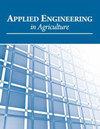利用概率模型评估玉米供应链中转基因不确定存在满足容忍度限值的可行性
IF 0.9
4区 农林科学
Q4 AGRICULTURAL ENGINEERING
引用次数: 0
摘要
大多数模拟场景显示满足0.9%和1.5%容差限制的可能性很低。在特定条件下,在供应链的某些阶段可以实现3.0%和5.0%的公差限制。各个供应链阶段的可行容差限制在2.25%到6.25%之间。种子纯度和异花授粉是影响AP耐受极限的关键因素。摘要在世界范围内,非转基因谷物、食品和饲料中转基因物质的意外存在(AP)的容忍限度从0.9%到5.0%不等。本研究分析了美国商品玉米供应链中AP达到四种常见贸易公差限制(0.9%、1.5%、3.0%和5.0%)的可能性。开发了一个模型,以评估同时处理转基因和非转基因产品的开放市场供应链中散装玉米生产、处理和加工的现有做法和模式。蒙特卡罗模拟用于测试供应链场景的50,000次迭代,以确定成功满足指定公差限制的可能性。该模型显示,在大多数情况下,目前存在的供应链并不能有效地促进在0.9%和1.5%公差限制下同时处理转基因和非转基因流。在单个供应链阶段,一些公差限制是可以合理实现的,例如在农场阶段的3.0%和5.0%。在养殖阶段,符合0.9%和1.5%容忍限值的概率分别略高于10%和67%,而符合3.0%和5.0%容忍限值的概率均超过90%。谷物提升机和谷物加工机在合理的可能性下可以达到3.0%和5.0%的公差极限。在饲料厂,5.0%的公差限制是可以实现的,但只有在绕过某些供应链阶段时才能实现。供应链各阶段99%可行容差范围为2.25% ~ 6.25%。通过敏感性分析确定了影响AP耐受能力的重要因素。这些因素包括种子杂质、异花授粉和运输工具。关键词:不定存在,玉米,饲料,转基因谷物,蒙特卡罗模拟,隔离,供应链。本文章由计算机程序翻译,如有差异,请以英文原文为准。
Assessing the Feasibility of Meeting Tolerance Limits for GM Adventitious Presence in Corn Supply Chain Using Probabilistic Modeling
Highlights Most simulated scenarios showed low probabilities of meeting with 0.9% and 1.5% tolerance limits. 3.0% and 5.0% tolerance limits were achievable at some supply chain stages under specific conditions. Feasible tolerance limits at individual supply chain stages ranged from 2.25% to 6.25%. Seed purity and cross-pollination were key factors affecting the probability of meeting AP tolerance limits. Abstract . Tolerance limits for the adventitious presence (AP) of GM material in non-GM grain, food, and feed vary worldwide from 0.9% to 5.0%. This research analyzed the likelihood of meeting four common trade tolerance limits for AP (0.9%, 1.5%, 3.0%, and 5.0%) in the U.S. commodity corn supply chain. A model was developed to evaluate existing practices and patterns for bulk corn production, handling, and processing in an open-market supply chain that concurrently handles GM and non-GM products. Monte Carlo simulation was used to test 50,000 iterations of supply chain scenarios to determine the likelihood of successfully meeting specified tolerance limits. The model revealed that the supply chain, as it exists today, does not effectively facilitate the concurrent handling of GM and non-GM streams at 0.9% and 1.5% tolerance limits in most cases. At individual supply chain stages, some tolerance limits were reasonably achievable, such as 3.0% and 5.0% at the farm stage. The probabilities of complying with 0.9% and 1.5% tolerance limits at the farm stage were just over 10% and 67%, respectively, while the probabilities of complying with 3.0% and 5.0% tolerance limits were more than 90%. The grain elevator and grain processor could achieve 3.0% and 5.0% tolerance limits with reasonable likelihood. At the feed mill, a 5.0% tolerance limit was achievable but only when bypassing some supply chain stages. The 99% feasible tolerance limits at individual supply chain stages ranged from 2.25% to 6.25%. Significant factors influencing the ability to meet AP tolerances were identified using sensitivity analysis. These factors included seed impurity, cross-pollination, and transportation vehicles. Keywords: Adventitious presence, Corn, Feed, Genetically modified grain, Monte Carlo simulation, Segregation, Supply chain.
求助全文
通过发布文献求助,成功后即可免费获取论文全文。
去求助
来源期刊

Applied Engineering in Agriculture
农林科学-农业工程
CiteScore
1.80
自引率
11.10%
发文量
69
审稿时长
6 months
期刊介绍:
This peer-reviewed journal publishes applications of engineering and technology research that address agricultural, food, and biological systems problems. Submissions must include results of practical experiences, tests, or trials presented in a manner and style that will allow easy adaptation by others; results of reviews or studies of installations or applications with substantially new or significant information not readily available in other refereed publications; or a description of successful methods of techniques of education, outreach, or technology transfer.
 求助内容:
求助内容: 应助结果提醒方式:
应助结果提醒方式:


